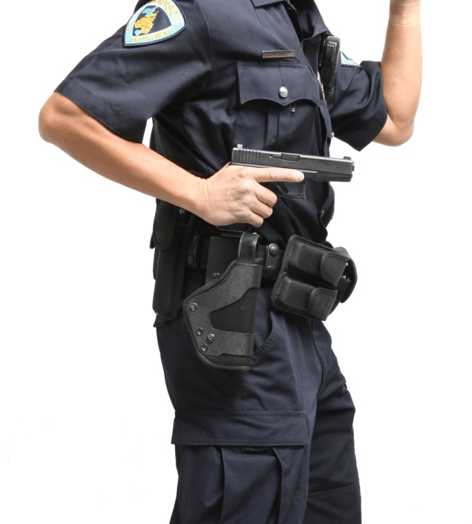All persons born or naturalized in the United States and subject to the jurisdiction thereof are citizens of the United States and of the State wherein they reside. No State shall make or enforce any law which shall abridge the privileges or immunities of citizens of the United States; nor shall any State deprive any person of life, liberty, or property, without due process of law; nor deny to any person within its jurisdiction the equal protection of the laws.
What is the 14th Amendment?
These are the two concepts that create the WI DAAT System.
What are Incident Response and Disturbance Resolution?
These are the three parts to the Disturbance Resolution Model.
What are Approach Considerations, Intervention Options, and Follow-Through Considerations?
1. Breathe in for a four-count through your nose.
2. Pause for a four-count.
3. Exhale for a four-count through your mouth.
4. Pause for a four-count.
What is Autogenic Breathing?
This step of the draw looks like this:

What is Step 2: Draw and Turn
These are two out of the six state statutes that allow an officer to make an arrest outside of his/her jurisdiction.
What are
- Fresh Pursuit: Wis. Stat. §175.40 (2) & (3)
- Close Pursuit: Wis. Stat. §967.04
- Mutual Aid: Wis. Stat. §66.0313
- Mutual Aid between States: Wis. Stat. §175.46
- Arrests; Assistance (on-duty, off-duty, outside jurisdiction): Wis. Stats. §175.40 (6)- a,b,c,d (6M)
- OWI: Wis. Stat. §349.03 (4)
These items make up Approach Considerations.
What are Decision Making, Tactical Deployment, and Tactical Evaluation?
This is the purpose of all law enforcement use of force.
What is to gain control in pursuit of a legitimate law enforcement objective?
These are two of the eight guidelines for crisis intervention.
- Pre-Intervention Preparation.
- Approach – Safety Considerations.
- Try to get the person’s attention.
- Check on the person’s perception of reality.
- Try to establish rapport with the person.
- Explain your perception of reality.
- Move toward resolution of the situation.
- Document/Debrief.
The rifle is loaded but a round is not chambered.
- Selector on safe
- Chamber empty with bolt closed
- Magazine loaded and inserted into the magazine well
- Rifle stored in squad car mount, gun case in trunk, etc.
What is Squad Ready?
The pursuit by a law enforcement officer of someone he/she has probable cause to believe has violated any law or ordinance the officer is authorized to enforce.
What is a Fresh Pursuit?
Threat Assessment Opportunities
Officer/Subject Factors
Special Circumstances
Level/Stage/Degree of Stabilization
What is Tactical Evaluation?
These are the six parts that make up follow-through considerations.
What are Stabilize, Monitor/Debrief, Search, Escort, Transport, Turn-over/Release?
A legal procedure by which law enforcement officers are authorized to take a mentally ill person, who presents a danger to himself or others (according to specified statutory criteria), into custody and take that person to a hospital or other treatment facility for evaluation, for up to 72 hours.
What is An Emergency Detention?
These are the four types of malfunctions a semi-auto pistol could experience.
What are Failure to fire, Failure to Extract, Failure to Eject, and Failure to Feed?
If a defendant is found not guilty at trial (acquitted), he or she cannot be re-tried for the same offense.
What is Double Jeopardy?
To overcome passive resistance, active resistance, or their threats.
What is the purpose of Control Alternatives?
A concept that involves an officer’s use of time, distance and relative positioning in combination with Professional Communication Skills to attempt to stabilize a situation and reduce the immediacy of threat posed by an individual.
What is De-escalation?
The acronym QPR can help you determine what to do in a suspected case of suicide. QPR is designed to help you help someone who may be considering suicide. QPR consists of these three life-saving skills.
What are
- Question a person about suicide.
- Persuade the person to get help.
- Refer the person to the appropriate resources
Subject behavior that justifies an officer’s use of deadly force. (word for word)
Behavior which has caused or imminently threatens to cause death or great bodily harm to you or another person or persons.
In this 1968 case, the U.S. Supreme Court ruled that the Fourth Amendment to the U.S. Constitution permits a law enforcement officer to stop, detain, and frisk persons who are suspected of criminal activity without first obtaining their consent, even though the officer may lack a warrant to conduct a search or probable cause to make an arrest.
What is Terry v. Ohio?
This is the word-for-word definition of deadly force.
What is "The intentional use of a firearm or other instrument that creates a high probability of death or great bodily harm."
These are the four tactics found in the mode of Control Alternatives.
What are Escort Holds, Compliance Holds, Control Devices (OC spray, ECD’s), and Passive Countermeasures?
These are the stages of the Crisis Cycle.
What are Normal State, Stimulation, Escalation, Crisis State, De-Escalation, Stabilization, and Post-Crisis Drain or depletion.
Accurately firing a handgun consists of mastering these five fundamentals.
What are Stance, Grip, Sight Alignment, Sight Picture, and Trigger Control?